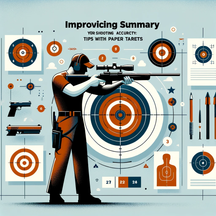Posted by Torres Targets on Feb 24th 2024
Improving Your Shooting Accuracy: Tips and Drills with Paper Targets
Accuracy is the cornerstone of proficient shooting, whether for sport, competition, or personal defense. Enhancing your shooting precision requires practice, patience, and the right approach. Paper targets, with their versatility and feedback capability, are invaluable tools in this quest. Here are practical tips and drills designed to improve your accuracy using paper targets.
Understand Your Basics
Mastering the fundamentals of shooting is the foundation upon which all successful marksmanship is built. Proper stance, whether isosceles, Weaver, or whatever stance you choo-choo-choose should offer stability and comfort, allowing for consistent shot placement. Grip strength and positioning affect recoil management and subsequent shots, necessitating a firm yet relaxed hold. Sight alignment demands focus, aligning the front and rear sights with the target to ensure accuracy. Trigger control is the final, critical step; smooth, steady pressure without disturbing the sight alignment is key. Achieving consistency in these areas is not merely beneficial; it is essential for any shooter looking to improve their accuracy. Regularly revisiting these basics, even as an experienced shooter, ensures continued growth and skill refinement.
Drill 1: The Slow-Fire Drill
The slow-fire drill emphasizes precision over speed, encouraging shooters to dedicate full attention to each phase of the shot. Starting at a relatively close range, such as 5 or 10 yards, allows for focused practice on mechanics without the added variable of long-distance aiming challenges. This drill is not just about hitting the center; it's an opportunity to evaluate and adjust your stance, grip, sight alignment, and trigger control with each shot. As muscle memory develops through repetition, the fundamentals become second nature, setting a solid foundation for more advanced drills and scenarios.
Drill 2: The Grouping Drill
The grouping drill advances the concept of precision by applying it across multiple targets and distances. By starting close, shooters can concentrate on tight groupings, usually aiming for groups within a few inches. As confidence and accuracy improve, increasing the distance challenges the shooter's ability to maintain precision under slightly different conditions, such as changes in sight picture and bullet drop. This drill is particularly effective for highlighting areas of improvement in aiming and trigger technique, as the physical feedback from the paper target provides clear evidence of performance.
Drill 3: The Timed Drill
Adding time pressure with the timed drill simulates the stress and urgency found in competitive shooting and real-life defensive situations. This drill tests not only the shooter's technical skills but also their ability to perform under pressure. The use of a timer introduces an external challenge, pushing shooters to find the balance between speed and accuracy. It's an excellent method for preparing for the dynamic environments of competition and self-defense, where efficiency can be as crucial as precision.
Use the Right Targets
The selection of paper targets should mirror the shooter's specific goals and the skills they wish to develop. Torres Targets' diverse array of options caters to a broad spectrum of training needs. Precision bullseyes are ideal for fundamental accuracy work, while tactical silhouettes can enhance scenario-based training, offering realistic shapes and situations. The choice of target can transform a routine drill into a tailored, skill-enhancing exercise, directly impacting the shooter's development and confidence.
Analyze Your Performance
Post-session analysis is a critical step in the improvement process. Reviewing the placement and grouping of shots on paper targets provides actionable insights into shooting habits and technique flaws. Patterns of misalignment, such as consistently hitting low and to the left, can indicate issues with trigger pull or improper grip. Recognizing these patterns allows for focused corrections and adjustments. Keeping a log of performance over time can also reveal progress and areas needing further improvement, making each practice session a building block towards greater accuracy and precision.
.
